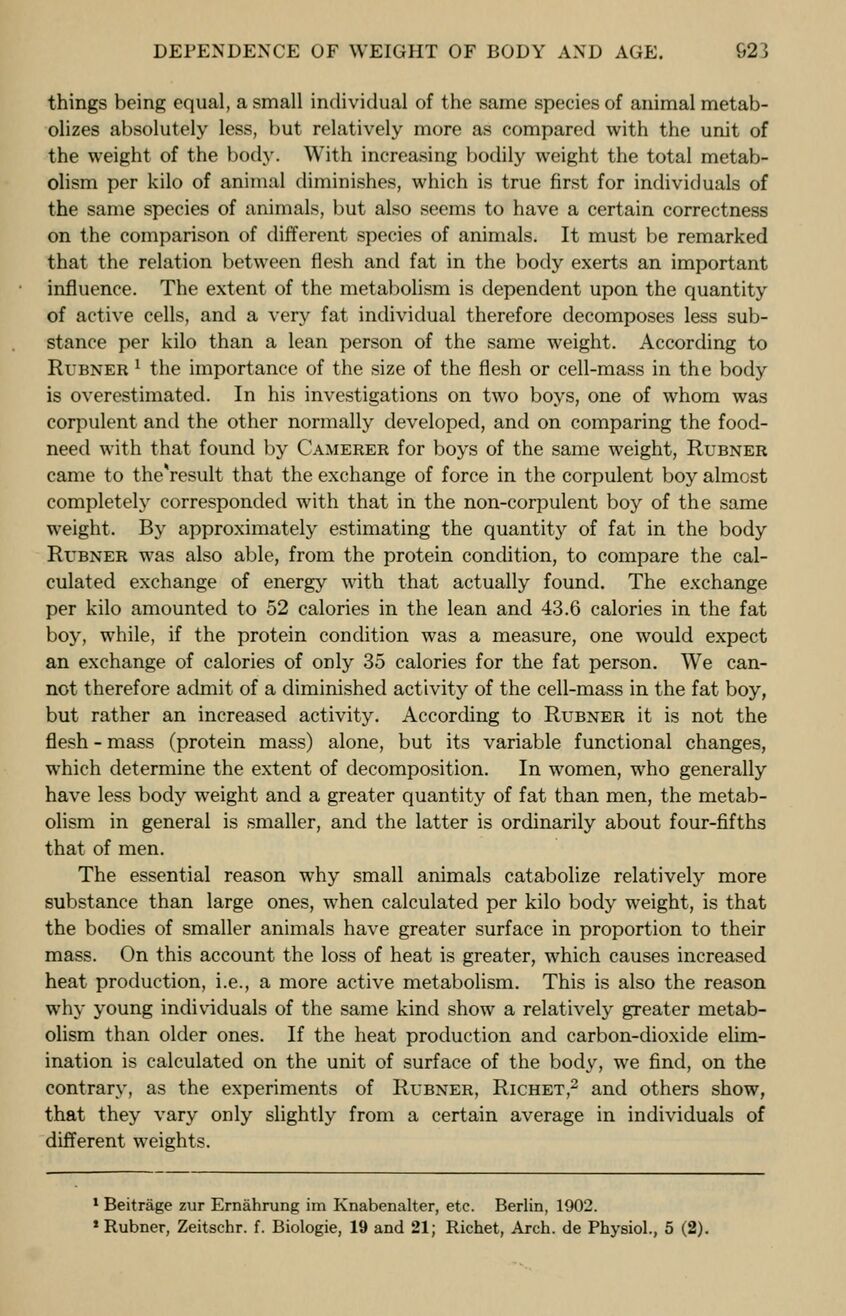
Full resolution (JPEG) - On this page / på denna sida - XVII. Metabolism - IV. The Dependence of Metabolism on other Conditions

<< prev. page << föreg. sida << >> nästa sida >> next page >>
Below is the raw OCR text
from the above scanned image.
Do you see an error? Proofread the page now!
Här nedan syns maskintolkade texten från faksimilbilden ovan.
Ser du något fel? Korrekturläs sidan nu!
This page has never been proofread. / Denna sida har aldrig korrekturlästs.
DEPENDENCE OF WEIGHT OF BODY AND AGE. 923
things being equal, a small individual of the same species of animal metab-
olizes absolutely less, but relatively more as compared with the unit of
the weight of the body. With increasing bodily weight the total metab-
olism per kilo of animal diminishes, which is true first for individuals of
the same species of animals, but also seems to have a certain correctness
on the comparison of different species of animals. It must be remarked
that the relation between flesh and fat in the body exerts an important
influence. The extent of the metabolism is dependent upon the quantity
of active cells, and a very fat individual therefore decomposes less sub-
stance per kilo than a lean person of the same weight. According to
Rubner l
the importance of the size of the flesh or cell-mass in the body
is overestimated. In his investigations on two boys, one of whom was
corpulent and the other normally developed, and on comparing the food-
need with that found by Camerer for boys of the same weight, Rubner
came to theVesult that the exchange of force in the corpulent boy almost
completely corresponded with that in the non-corpulent boy of the same
weight. By approximately estimating the quantity of fat in the body
Rubner was also able, from the protein condition, to compare the cal-
culated exchange of energy with that actually found. The exchange
per kilo amounted to 52 calories in the lean and 43.6 calories in the fat
boy, while, if the protein condition was a measure, one would expect
an exchange of calories of only 35 calories for the fat person. We can-
not therefore admit of a diminished activity of the cell-mass in the fat boy,
but rather an increased activity. According to Rubner it is not the
flesh - mass (protein mass) alone, but its variable functional changes,
which determine the extent of decomposition. In women, who generally
have less body weight and a greater quantity of fat than men, the metab-
olism in general is smaller, and the latter is ordinarily about four-fifths
that of men.
The essential reason why small animals catabolize relatively more
substance than large ones, when calculated per kilo body weight, is that
the bodies of smaller animals have greater surface in proportion to their
mass. On this account the loss of heat is greater, which causes increased
heat production, i.e., a more active metabolism. This is also the reason
why young individuals of the same kind show a relatively greater metab-
olism than older ones. If the heat production and carbon-dioxide elim-
ination is calculated on the unit of surface of the body, we find, on the
contrary, as the experiments of Rubner, Richet,2
and others show,
that they vary only slightly from a certain average in individuals of
different weights.
1
Beitrage zur Ernahrung im Knabenalter, etc. Berlin, 1902.
* Rubner, Zeitschr. f. Biologie, 19 and 21; Richet, Arch, de Physiol., 5 (2).
<< prev. page << föreg. sida << >> nästa sida >> next page >>